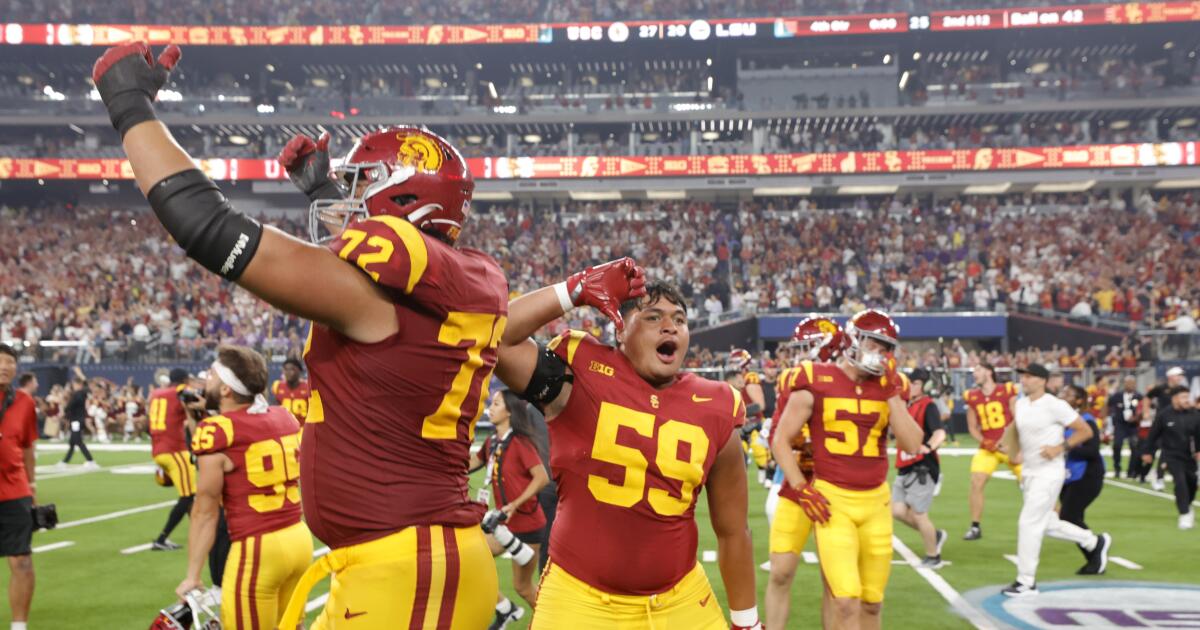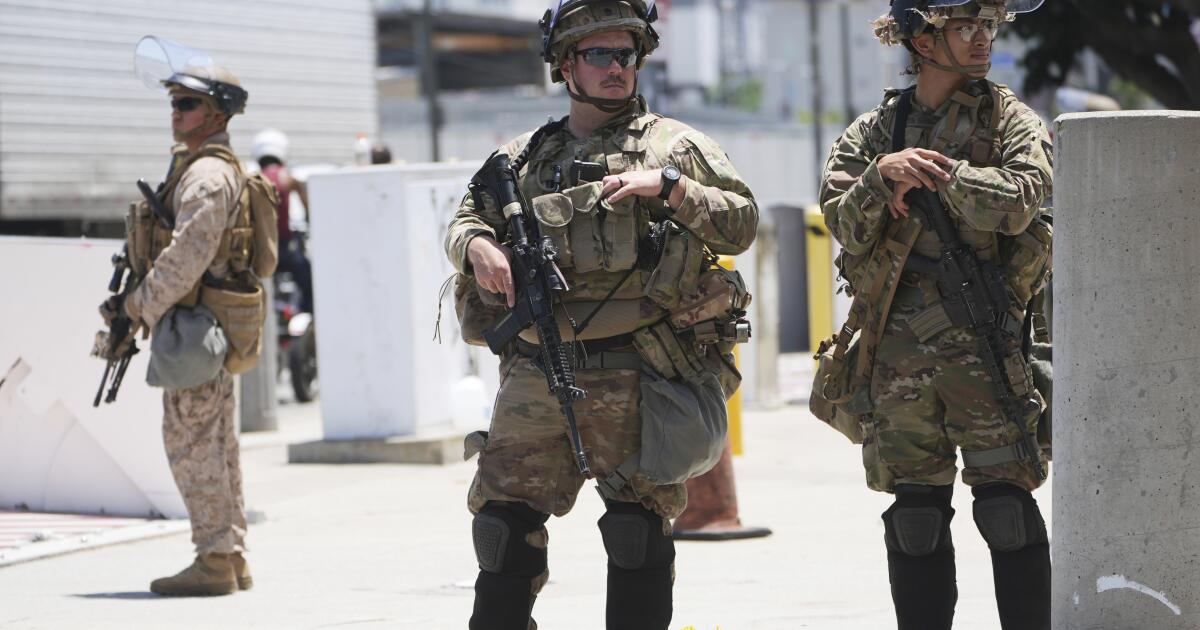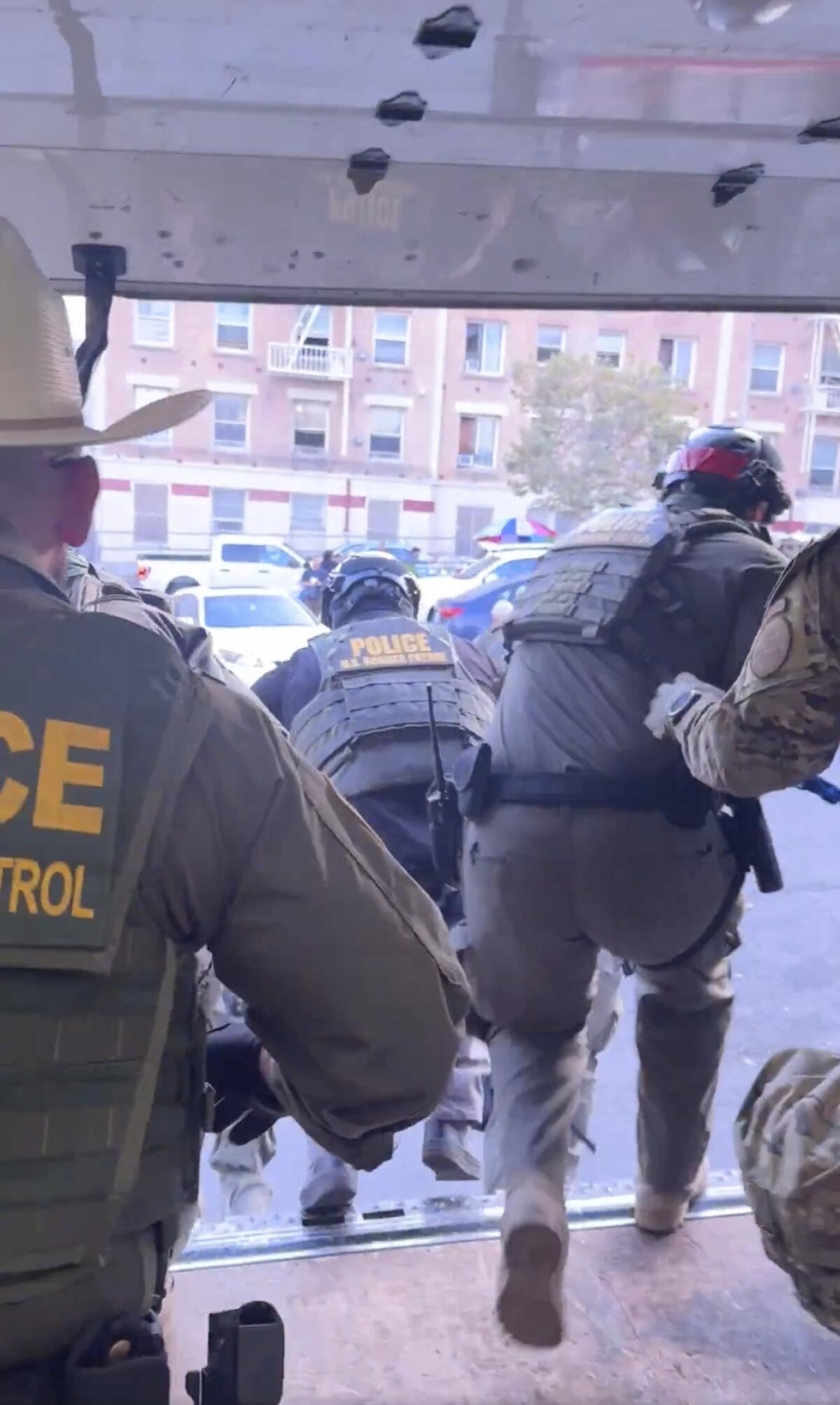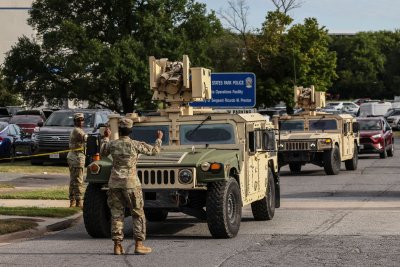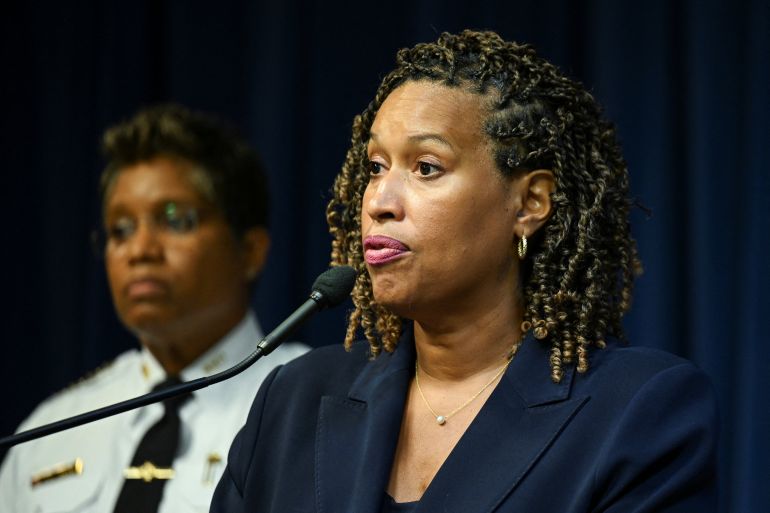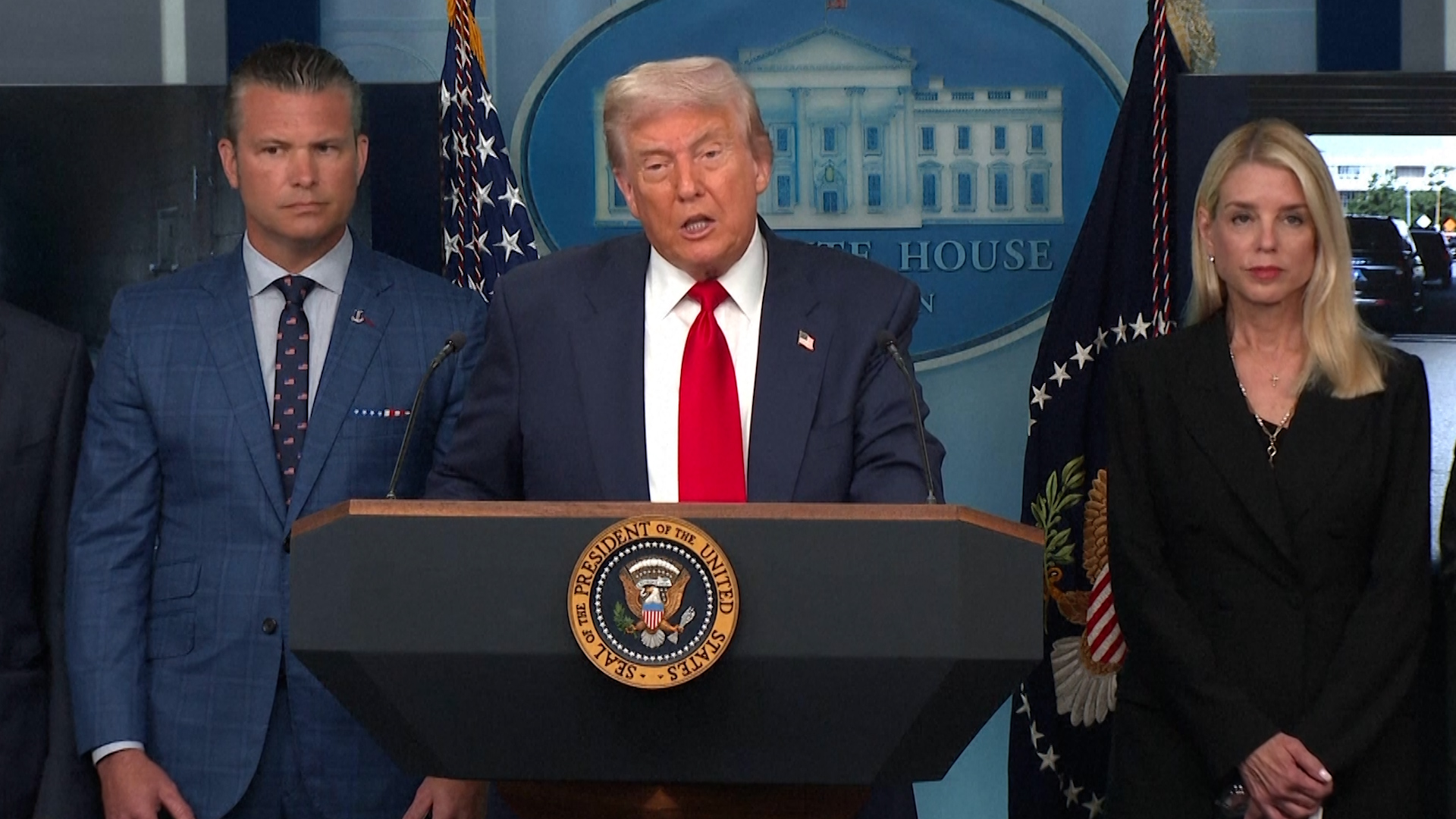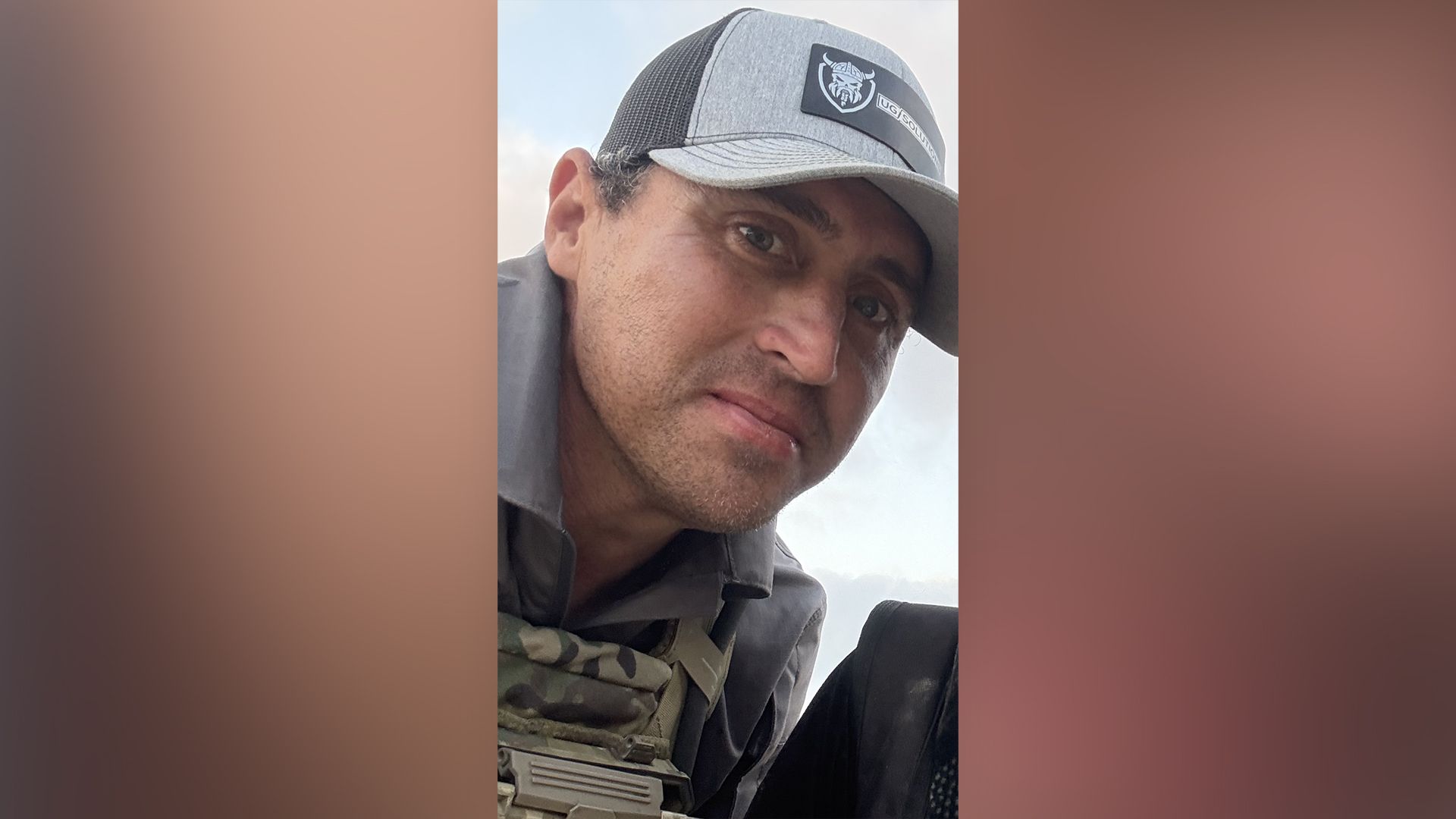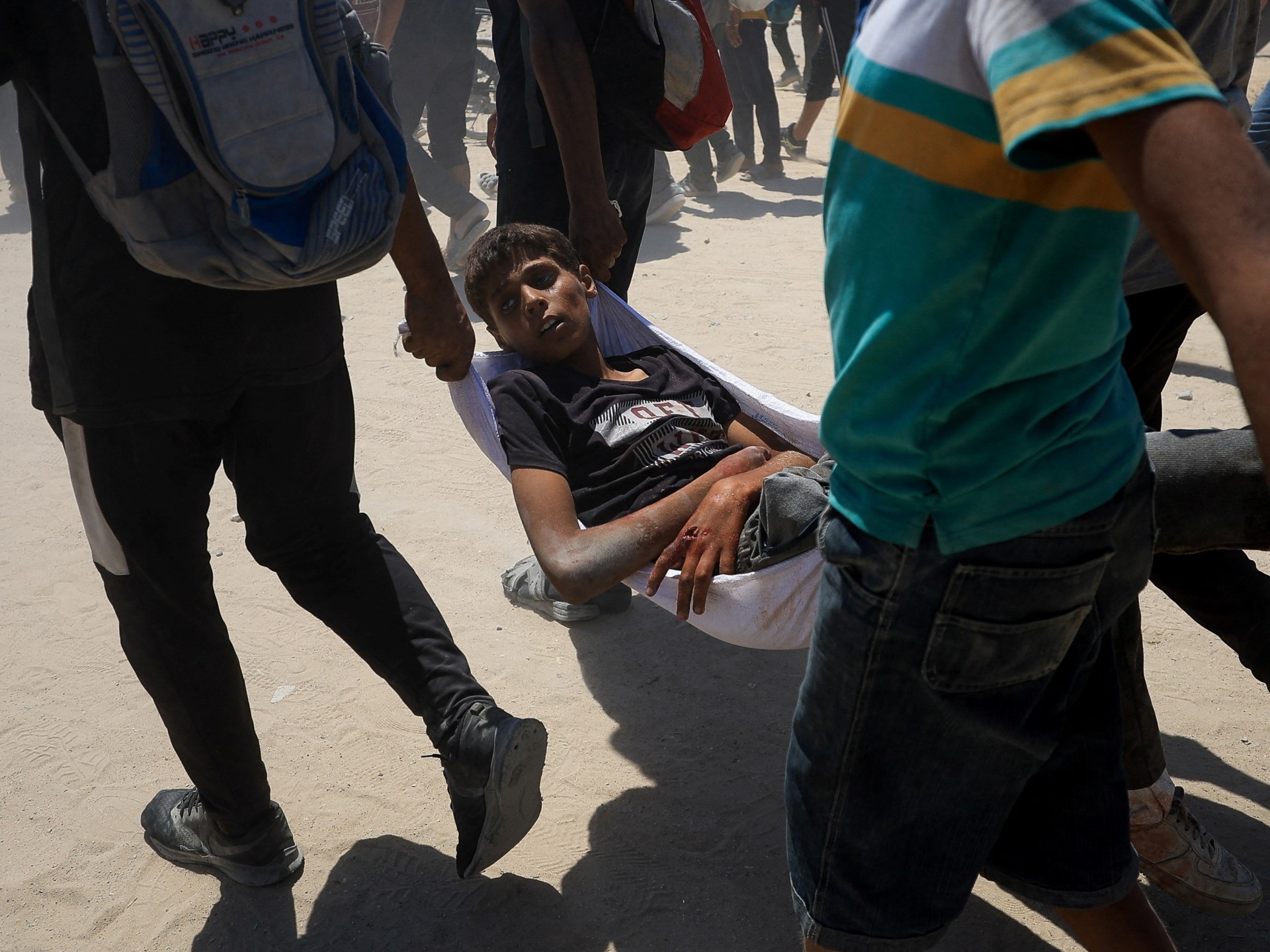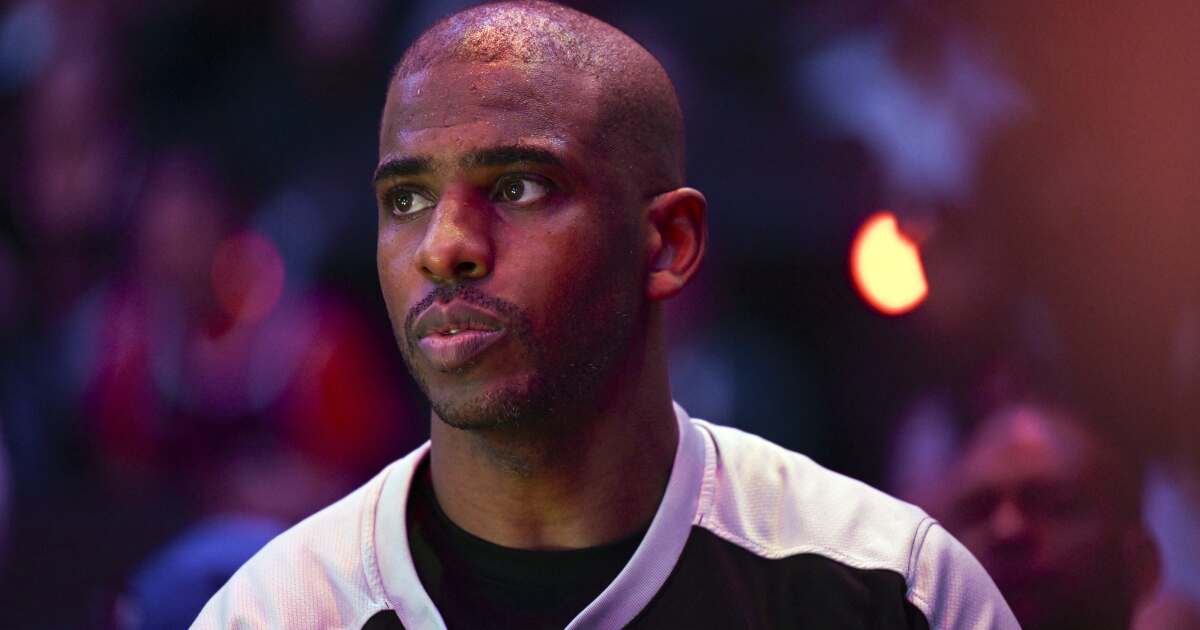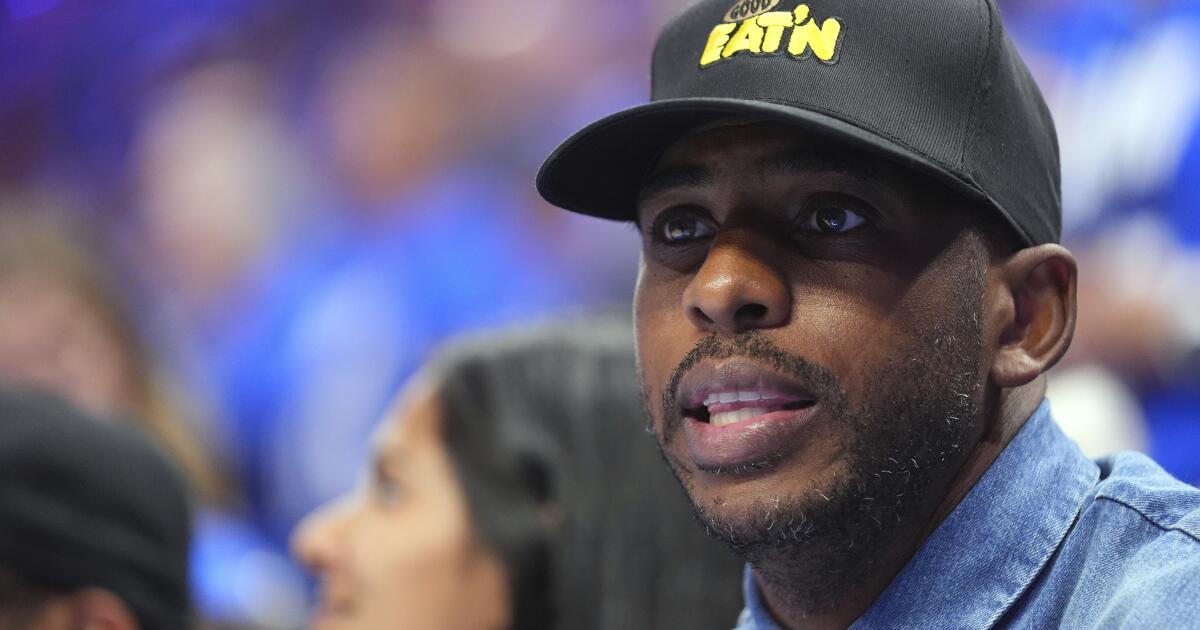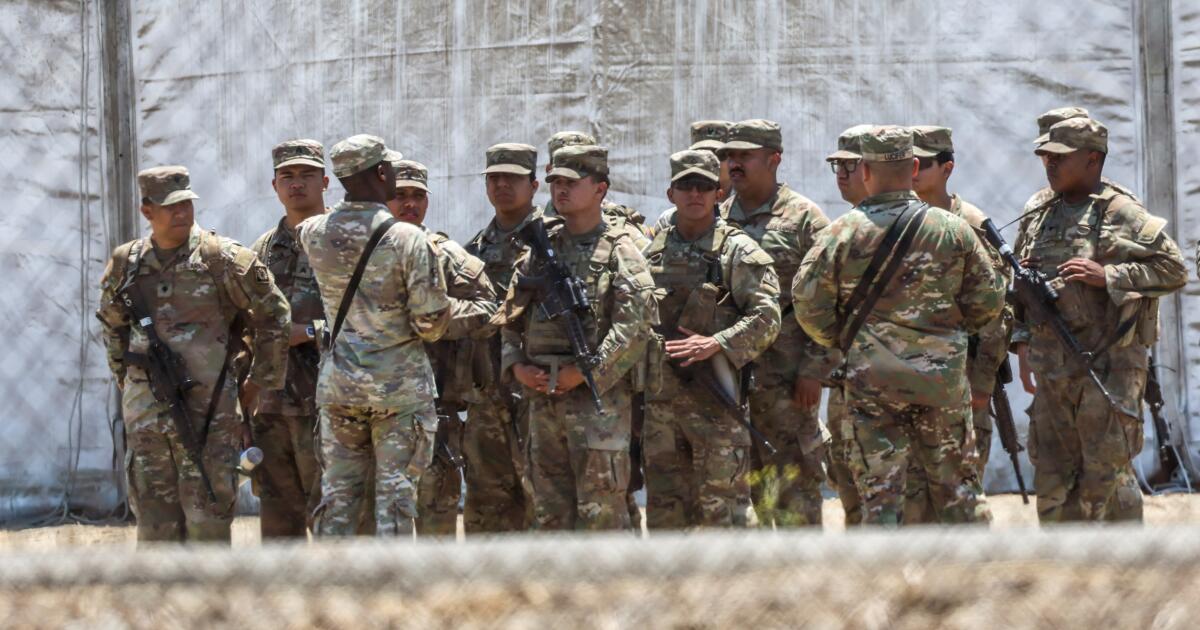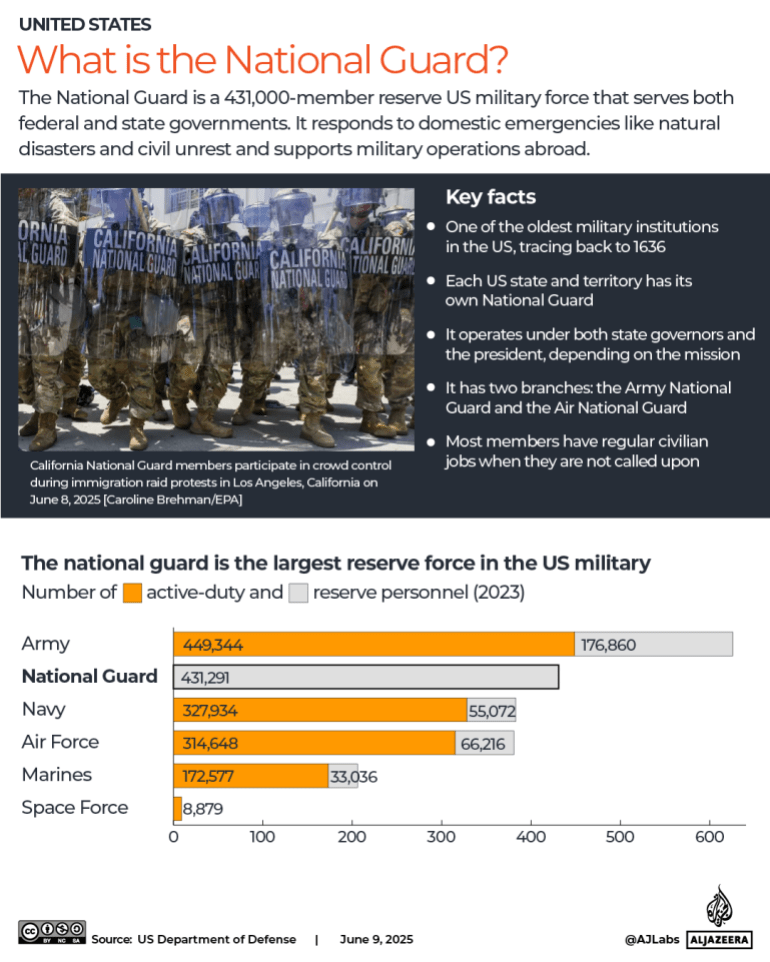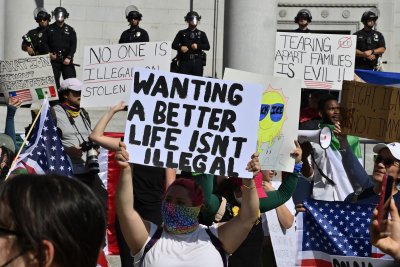They were deployed by the Trump administration to combat “violent, insurrectionist mobs” in and around Los Angeles, but in recent days the only thing many U.S. Marines and California National Guard troops seemed to be fighting was tedium.
“There’s not much to do,” one Marine said as he stood guard outside the towering Wilshire Federal Building in Westwood this week.
The blazing protests that first met federal immigration raids in downtown Los Angeles were nowhere to be seen along Wilshire Boulevard or Veteran Avenue, so many troops passed the time chatting and joking over energy drinks. The Marine, who declined to give his name because he was not authorized to speak to reporters, said his duties consisted mostly of approving access for federal workers and visitors to the Veterans Affairs office.
More than five weeks after Trump mobilized an extraordinary show of military force against the will of California Gov. Gavin Newsom and L.A. Mayor Karen Bass, few National Guard troops and Marines have remained in public view, most retreating to local military bases in Orange County.
As an indication of the military’s dwindling role in immigration enforcement operations, U.S. Secretary of Defense Pete Hegseth on Tuesday ordered the release of 2,000 National Guard troops. Now, Bass, Newsom and others are demanding the complete removal of remaining troops — or about 2,000 California National Guard soldiers and 700 Marines.
“Thousands of members are still federalized in Los Angeles for no reason and unable to carry out their critical duties across the state,” Newsom said on X, accusing Trump of using California National Guard troops as “political pawns.”
“End this theater and send everyone home,” the governor said.
Bass said the troops’ primary mission in L.A. was to guard federal buildings that “frankly didn’t need to be guarded.”
“They had to leave their families, they had to leave their education, they had to leave their work,” Bass said at a news conference Tuesday. “We have had no problems for weeks, so why were they here?”
Steve Woolford, a resource counselor for GI Rights Hotline, a nonprofit group that provides free, confidential information to service members, said calls from troops had gone down dramatically over the last month.
“The most recent people I talked to sounded like they’re sitting around bored without much to do,” Woolford said. “And they’re happy with that: They aren’t asking to do more. At the same time, I don’t think people see a real purpose in what they’re doing at all.”
The majority of National Guard troops have been stationed at the Joint Forces Training Base in Los Alamitos, according to military officials and governor’s office officials who spoke on the condition of anonymity.
Over the last few weeks, a massive tent city has risen at the Orange County base — about 25 miles southeast of downtown L.A. The tents, some of which stretch up to 50 yards long, provide living quarters, cafeteria space and other facilities. On a recent morning, National Guards troops — some dressed in full combat fatigues, others in T-shirts and shorts — could be seen exercising, milling about and playing a game of touch football.
A separate group of Marines and National Guard troops have remained at the Westwood federal building for an entire month. The federal building has been outfitted with sleeping and eating arrangements for troops, according to a Marine who spoke with The Times.
To be sure, some California National Guard troops embarked on tense missions with federal immigration agents on sweeps at farms, warehouses and public streets.
On July 7, Guard troops accompanied federal agents as they descended on MacArthur Park on horses and in armored vehicles in a heavily militarized show of force. It’s still unclear whether any arrests were made that day, but crowds quickly formed around the federal agents and military troops, screaming for them to “get the f— out!”
A few days later, Guard troops wearing riot face shields and clutching long, wooden batons faced off with hundreds of protesters in Ventura County as immigration agents arrested about 200 suspected undocumented immigrants at Glass House Farms, a large, licensed cannabis greenhouse in Camarillo.
But most of the deployed Guard troops and Marines do not appear to have been engaged in raids or even the federal building security in recent weeks.
An estimated 90% of the National Guard troops stationed in the L.A. area over the last few days have not been deployed on daily missions, according to a source within Newsom’s office who has knowledge of the military operation.
“For the most part … they’re sitting around,” the source said.
The source, who spoke on condition on anonymity because they were unauthorized to speak publicly on the deployment, said an estimated 3% of the 4,000 troops — about 120 soldiers — were taking part in daily missions, mostly consisting of security at federal buildings.
An additional couple hundred were standing by for “quick response force” missions — ready to mobilize within a few hours for an immigration raid or a crowd control operation. But even if all those troops were used each day, the source said, that still left about 88% of the 4,000 troops — or about three-quarters of the remaining 2,000 — underutilized.
The Pentagon and Task Force 51, the military’s designation for Los Angeles area troops, declined to answer questions about how many Guard troops and Marines were engaged in protecting federal buildings or accompanying immigration agents on daily missions. Nor did they comment on the claim from Newsom’s office that most troops were “sitting around.”
Guard soldiers and Marines were “primarily protecting fixed-site federal facilities and protecting federal law enforcement personnel while they conduct immigration enforcement activities, such as warrant services,” read a task force statement.
Federal officials have also declined to provide precise details on the cost of the deployment. Hegseth previously said that the mobilization of troops would cost $134 million, but it’s unclear whether that estimate is accurate.
Jennifer Kavanagh, director of military analysis at Defense Priorities, a military research group, said there is little evidence that the military presence is necessary.
“The need for military forces in Los Angeles is low while the need for National Guard forces elsewhere in the state is rising,” Kavanagh said. “That they’re still deployed after so much time, when there doesn’t seem to be a need, suggests that this really is about setting precedent of having military forces involved in immigration enforcement and deployed in U.S. cities.”
Kori Schake, senior fellow and director of foreign and defense policy studies at the American Enterprise Institute, agreed: “They have a real job to be training for — fighting and winning the nation’s wars — which this performative policing is a distraction from.”
The first convoys of Guard troops rumbled into L.A. on June 8, shortly after the Trump administration announced it would send 2,000 Guard members to the city to quell unrest as protesters graffitied buildings downtown, set Waymo driverless cars ablaze and clashed with ICE agents as they tried to conduct immigration raids.
As California leaders protested, and called the deployment unnecessary, the Trump administration doubled down. On June 10, 700 Marines from the Marine Corps Air Ground Combat Center about 150 miles west in Twentynine Palms arrived in L.A. A week later, the task force ballooned to 4,800 personnel when Hegseth added 2,000 more Guard troops.
Newsom condemned Trump for diverting members of the California National Guard as they geared up for wildfire season, noting that the unit assigned to combating wildfires was at just 40% of its regular staffing levels due to the deployment. The governor’s office also complained that about 150 California Guard soldiers were being pulled from the state’s Counterdrug Task Force, which focuses on interrupting drug trade at the U.S.-Mexico border and throughout California.
The Trump administration eventually approved a request to release 150 Guard members for state wildfire suppression.
The Guard has been deployed to Los Angeles before, but never against the will of the L.A. mayor and California governor.
In 1992, President George H.W. Bush mobilized the National Guard to L.A. after multiple days of riots following a jury’s acquittal of four white police officers in the beating of Black motorist Rodney King. About 6,000 troops were ultimately sent in, requested by California’s then-Gov. Pete Wilson and Mayor Tom Bradley, to guard trouble spots and gain control of neighborhoods after rioters attacked stores, torched buildings and, in some extreme cases, beat and killed residents. The Times dubbed it “the worst civil unrest in Los Angeles history.”
Nearly 30 years later, Guard troops were called in again during the 2020 protests following the murder of George Floyd. After downtown buildings were vandalized and graffitied and police cars were set aflame, L.A. Mayor Eric Garcetti asked Newsom to send in 1,000 National Guard troops to restore order and assist local law enforcement.
But last month, the federal government sent in the troops without local politicians’ support, setting in motion an intense legal showdown.
A day after National Guard troops hit the ground in L.A., Newsom and Atty. Gen. Rob Bonta filed a lawsuit against the Trump administration to end the “illegal and unnecessary takeover” of a California National Guard unit. They argued that the unwarranted commandeering of National Guard troops, without the consent or input of the governor, violated the U.S. Constitution and exceeded the president’s Title 10 authority.
A U.S. district judge in San Francisco sided with the state, ruling June 12 that Trump broke the law when he deployed thousands of California National Guard troops to L.A. against the state’s will. The judge issued a temporary restraining order that would have returned control of the National Guard to California. But the U.S. 9th Circuit Court of Appeals paused that court order, allowing the troops to remain in L.A. while the case played out in federal court.
Kavanagh said she was disturbed to see Guard troops accompanying federal agents on immigration raids. Even if they had orders not to participate in law enforcement activities, confrontations could escalate quickly.
“There’s so many chances for things to spiral out of control,” she said. “While we haven’t seen any unintentional escalation yet, that doesn’t mean we won’t.”
When troops were first deployed to L.A., advocates for service members warned of low morale. The GI Rights Hotline received a flurry of calls voicing concern about immigration enforcement, Woolford said.
Some military personnel told the hotline that they did not want to support ICE or play any role in deporting people because they considered immigrants part of the community or had immigrants in their family, Woolford said. Others said they did not want to point guns at citizens. A few worried that the country was on the verge of turning into something like martial law, and said that they didn’t want to be on the side of being armed occupiers of their own country.
Many were shocked that the deployment orders were for 60 days.
“There’s no way they’re really going to keep us here that long, are they?” Woolford said he was asked.
But as the military brought in more contractors and set up giant tents with cots, Woolford said, callers to the hotline seemed more resigned to the idea that they would remain in L.A. a long time.
Asked about the pressures facing troops on their mission to Los Angeles, one Marine outside the Wilshire Federal Building summed it up this way:
“That’s just orders,” he said. “We do what we’re told — it’s the system.”
Times staff writer Jeanette Marantos contributed to this report.
